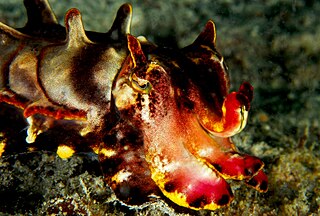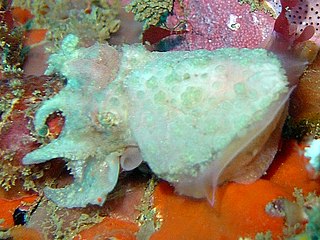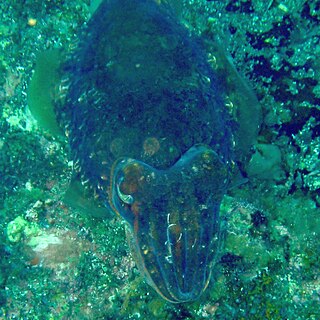
Metasepia pfefferi, also known as the flamboyant cuttlefish, is a species of cuttlefish occurring in tropical Indo-Pacific waters off northern Australia, southern New Guinea, as well as numerous islands of the Philippines, Indonesia and Malaysia.
Sepia angulata is a species of cuttlefish native to the southeastern Atlantic Ocean, from Bloubergstrand to Still Bay. It is known only from cuttlebones. The validity of S. angulata has been questioned.
Sepia bartletti is a species of cuttlefish native to the western Pacific Ocean. It is known only from the type locality. Depth range is unknown. Some authorities regard S. bartletti as a nomen dubium.
Sepia baxteri is a species of cuttlefish native to the southwestern Pacific Ocean, specifically the waters around Lord Howe Island. It is known only from the type cuttlebones. Depth range is unknown.
Sepia burnupi is a species of cuttlefish native to the southwestern Indian Ocean, specifically southeast Africa, from Port Elizabeth to southern Mozambique and the Saya-de-Malha Bank. It lives at a depth of between 40 and 240 m.
Sepia faurei is a species of cuttlefish native to the southwestern Indian Ocean, specifically to the east of the Cape of Good Hope, South Africa. It lives at depths to 168 m.
Sepia insignis is a species of cuttlefish native to the southwestern Indian Ocean, specifically South Africa, from the Cape of Good Hope to Natal. It lives at depths to 42 m.
Sepia kiensis is a species of cuttlefish native to the Indo-Pacific, specifically the Kai Islands, possibly to Timor and northern Australia. It lives at depth to 256 m. The validity of S. kiensis has been questioned.
Sepia koilados is a species of cuttlefish native to the southeastern Indian Ocean, specifically the North West Shelf in western Australia. It lives at depths of between 182 and 203 m.

Sepia mestus, also known as the reaper cuttlefish or red cuttlefish, is a species of cuttlefish native to the southwestern Pacific Ocean, specifically Escape Reef off Queensland to Murrays Beach off Jervis Bay. Reports of this species from China and Vietnam are now known to be misidentifications. S. mestus lives at a depth of between 0 and 22 m.
Sepia hedleyi, or Hedley's cuttlefish, is a species of cuttlefish in the family Sepiidae, endemic to subtropical and temperate waters off Australia.
Sepia peterseni is a species of cuttlefish native to the western Pacific Ocean. Its natural range stretches south of central Honshū to southern Kyūshū, and it is also present in South Korea. It lives on the inner shelf at depths of between 20 and 100 m.
Sepia plana is a species of cuttlefish native to the coast of Australia, specifically the North West Shelf. However, cuttlebones of this species have also been found off eastern Australia, suggesting that it may have a wider distribution. S. plana lives at depths of between 396 and 505 m.
Sepia reesi is a species of cuttlefish native to the southeastern Indian Ocean. Cuttlebone of this species known only from the type locality.
Sepia saya is a species of cuttlefish known only from its type locality in the southwestern Indian Ocean. It lives at depths of 87 to 117 m.

Sepia tuberculata is a species of cuttlefish native to South African waters from Melkbosstrand to Knysna. It belongs to the genus Sepia. It lives in very shallow water to a depth of 3 m. It is endemic.
Sepia vercoi is a species of cuttlefish native to the southeastern Indian Ocean, specifically the waters off Western Australia. It lives at depths of 76 to 201 m.
Sepia braggi, the slender cuttlefish, is a species of cuttlefish native to the Indo-Pacific Ocean. It has been found in coastal waters of southern Australia. This species was first collected in South Australia by its namesake, William Lawrence Bragg. Sepia braggi was then described by Sir Joseph Cooke Verco in 1907.Sepia braggi is part of the subgenus Doratosepion which contains to 41 species of cuttlefish in total.

Sepia orbignyana, the pink cuttlefish, is a species of small cuttlefish from the family Sepiidae. It is occurs in the temperate and tropical waters of the eastern Atlantic Ocean.

Sepia hierredda, the giant African cuttlefish, is a species of cuttlefish from the family Sepiidae, which was previously considered conspecific with the common cuttlefish Sepia officinalis. It is found along the western coast of Africa and is an important species to fisheries.






